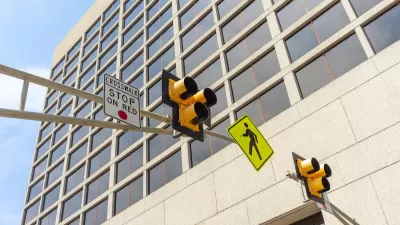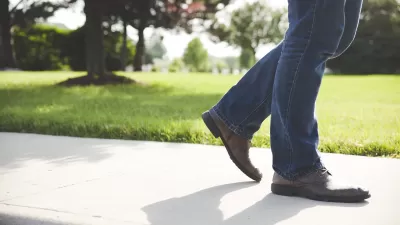The new formulas for calculating the length of walk signals are designed to give people more time to safely cross the street.

"Determining how much time a pedestrian needs to safely cross the road at a crosswalk is surprisingly complicated," writes Michelle Baruchman in the Seattle Times. City engineers employ "a set of formulas that consider the width of the street, an average walking pace and intersection design, among other things" to calculate the amount of time needed for each intersection. Until recently, the Seattle Department of Transportation (SDOT) used an average walking speed of 3.5 feet per second. "Now, through conversations with a pedestrian-focused advisory group, SDOT has updated its guidelines to give people a little more time to cross — a move celebrated by advocates for seniors and people with disabilities."
Pedestrian advocates applaud the move as one of many possible "seemingly small tweaks" that "can make a big difference in street safety, without requiring major construction or costs." Akira Ohiso, a social worker with Sound Generations, an organization that provides activities for seniors, cited prior conditions as unsafe, saying that "crosswalks in busy urban streets do not allow enough time for older adults to cross safely, especially four-lane streets." The new guidelines call for recalculating the timing "when existing intersections are modified, when community members request a change and when new signals are installed." For drivers, the changes will "mostly balance out," according to SDOT spokesperson Ethan Bergerson, as "slightly longer red lights usually also lead to longer green lights."
The change comes as part of a broader move to improve pedestrian safety in the city that includes curb bulbs, leading pedestrian intervals, and guidance on whether intersections require push-to-walk buttons or automatic signals.
FULL STORY: Why the ‘walk’ signals at some Seattle crosswalks seem a little longer now

Alabama: Trump Terminates Settlements for Black Communities Harmed By Raw Sewage
Trump deemed the landmark civil rights agreement “illegal DEI and environmental justice policy.”

Study: Maui’s Plan to Convert Vacation Rentals to Long-Term Housing Could Cause Nearly $1 Billion Economic Loss
The plan would reduce visitor accommodation by 25% resulting in 1,900 jobs lost.

Why Should We Subsidize Public Transportation?
Many public transit agencies face financial stress due to rising costs, declining fare revenue, and declining subsidies. Transit advocates must provide a strong business case for increasing public transit funding.

Wind Energy on the Rise Despite Federal Policy Reversal
The Trump administration is revoking federal support for renewable energy, but demand for new projects continues unabated.

Passengers Flock to Caltrain After Electrification
The new electric trains are running faster and more reliably, leading to strong ridership growth on the Bay Area rail system.

Texas Churches Rally Behind ‘Yes in God’s Back Yard’ Legislation
Religious leaders want the state to reduce zoning regulations to streamline leasing church-owned land to housing developers.
Urban Design for Planners 1: Software Tools
This six-course series explores essential urban design concepts using open source software and equips planners with the tools they need to participate fully in the urban design process.
Planning for Universal Design
Learn the tools for implementing Universal Design in planning regulations.
Caltrans
Smith Gee Studio
Institute for Housing and Urban Development Studies (IHS)
City of Grandview
Harvard GSD Executive Education
Toledo-Lucas County Plan Commissions
Salt Lake City
NYU Wagner Graduate School of Public Service





























